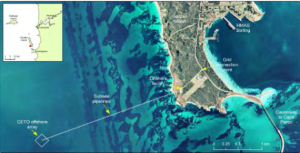Source: cleantechnica.com
Published: November 2, 2015

Originally published on RenewEconomy.
By Sophie Vorrath
Western Australian wave power company Carnegie Wave Energy has revealed that it is collaboration with WA network operator Western Power to develop the world’s first wave-integrated renewable energy microgrid project to be connected to an electricity network.
The Garden Island Microgrid Project will consist of Carnegie’s CETO 6 array, which is currently in progress, as well as the existing reverse osmosis desalination plant that is currently operating on Garden Island after being switched on last week.
The microgrid will also have an additional 2MW peak, of solar PV power generation, as well as sufficient energy storage to allow safe, stable and reliable interaction with the electricity grid.
The announcement comes seven months after the ASX-listed Carnegie switched on its ground-breaking array of CETO 5 generators off Garden Island in Perth, sending wave-generated electricity into the local grid.
The CETO 6 design, the conceptual phase of which was completed just two weeks ago, has a number of advantages over the CETO 5 model, including a roughly four-times increase in rated capacity to 1MW.
The team have also identified a preferred site for the CETO 6 array, some 10km offshore from Garden Island.
Detailed design of the project is targeted for completion in mid-2016. It will be developed with the support of the Australian Department of Defence – who occupy a base on Garden Island – and and will be funded through a combination of equity, debt and grant funding, including a five-year, $20 million loan facility from the Clean Energy Finance Corporation, and an $11 million grant from the Australian Renewable Energy Agency.
Carnegie CEO, Michael Ottaviano said Western Australia presented itself as an attractive option to use wave power projects to avoid building and maintaining long transmission lines to coastal communities.
He said the Garden Island project would also help demonstrate the great potential the company sees to integrate its wave energy technology into islands as well as fringe-of-grid applications, wherever there is a strong wave resource.
“Carnegie’s island power projects will invariably involve integrating CETO with other renewable energy power sources, desalination plants, diesel generation and increasingly energy storage,” he said in a statement on Thursday.
“This project will also be a great opportunity to demonstrate a real world, wave integrated microgrid system to our island customers”.
Already, Carnegie has entered deals to develop projects in Chile and Peru, including power and desalinated water for the Easter and Robinson Crusoe islands.
